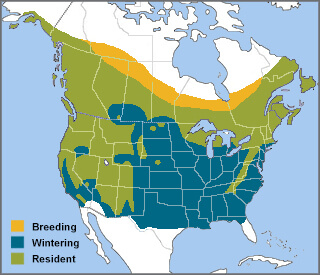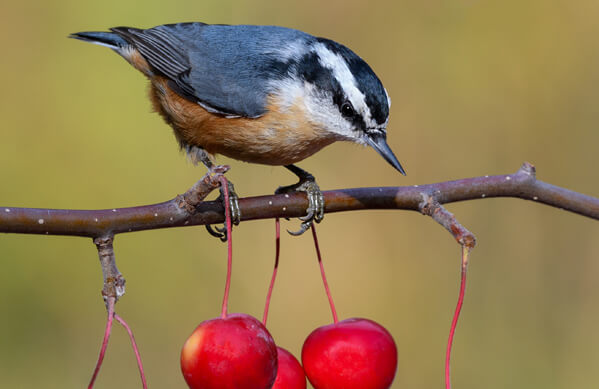
Red-breasted Nuthatch range map by ABC
Once known as the Canada Nuthatch or Red-bellied Nuthatch, the active, compact Red-breasted Nuthatch is a common resident of northern and western coniferous and mixed forests in the United States and Canada. Usually well-hidden within the thick forest it favors, this bird's distinctive, tinny-sounding call is often heard before it is seen. Once spotted, the adult Red-breasted Nuthatch is unmistakable, with an eye-catching black-and-white head pattern, blue-gray upperparts, and a reddish-orange belly.
Like its larger relative the White-breasted Nuthatch, the Red-breasted Nuthatch has strong feet, toes, and long, curved claws that allow it to climb down trees headfirst, or to clamber upside-down along the undersides of branches.
The Red-breasted Nuthatch is the most migratory member of its normally sedentary family.
Winter Wanderer
This species stages regular "irruptions" — during which large numbers of individuals move farther south than usual in response to a lack of winter food. Other boreal bird species stage similar irruptions, including the Pine Siskin, Evening Grosbeak, and Snowy Owl, and White-breasted Nuthatches were recently found to do the same, though on a much smaller scale. In the case of the Red-breasted Nuthatch, poor cone crops spur this bird's periodic movements southward.
Sometimes, wayward Red-breasted Nuthatches travel as far south as the Gulf Coast and Northern Mexico. This species is even a very rare vagrant to Europe — the only North American nuthatch to have made the long journey across the Atlantic. It has also been recorded on St. Lawrence Island in the Bering Sea, not far from Russia.
Tiny Tin Trumpet
Although the Red-breasted Nuthatch is normally resident in most of its range, it may withdraw from the northernmost areas in response to severe weather and/or food scarcity (see above).
Its breeding range covers much of the conifer forest belt that stretches from Alaska to Newfoundland and Labrador, south through the Great Lakes region, northern New England, and also in the higher elevations of the Appalachians to eastern Tennessee and North Carolina. In the West, it occurs in coniferous forests south to California and Arizona.
The call of the Red-breasted Nuthatch is a nasal, tinny yank-yank, higher-pitched than the White-breasted Nuthatch. The "tin horn" quality of this call is reminiscent of a much larger bird — the Ivory-billed Woodpecker, sadly now extinct.
Unlike other nuthatches, the Red-breasted also uses song to woo females during courtship.
Listen here:
(Audio: Martin St-Michel, XC319180. Accessible at www.xeno-canto.org/319180. Ross Gallardy, XC344953. Accessible at www.xeno-canto.org/344953)
Ivory-billed Woodpecker call: https://www.allaboutbirds.org/guide/Ivory-billed_Woodpecker/sounds#
A Switch in Diet
The Red-breasted Nuthatch forages by gleaning its way up and down tree trunks and branches. During the spring and summer, this bird seeks insects and spiders and their larvae and eggs; in the winter, the diet switches to conifer seeds and nuts. These latter food items can be tough to break apart, but the resourceful nuthatch overcomes that challenge by wedging a tough seed or nut into a bark crevice, then hacking it into smaller pieces with its strong, slightly upturned bill. This distinctive habit, called "hatching," gives the birds in this avian family the name "nuthatch."
This scrappy little nuthatch readily visits backyard feeders for nuts, seeds, and suet, holding its own against larger feeder visitors such as the Tufted Titmouse, Northern Cardinal, and Blue Jay.

Red-breasted Nuthatch by Betty Rizzotti
Like other winter residents such as the Black-capped Chickadee, the Red-breasted Nuthatch caches extra food under bark and in tree crevices and holes. These hidden stores help these birds survive food shortages during harsh weather.
A Sappy Entrance
The Red-breasted Nuthatch is monogamous during its breeding season, and pairs may remain together on their territory through the following winter. The male courts his mate in a swaying and singing display with raised head, drooping wings, and fluffed-out back feathers. He also brings food to the female during courtship.
One interesting facet of Red-breasted Nuthatch biology is that mated pairs prefer to excavate their own nest cavities, rarely using existing cavities or nest boxes. Both male and female work to excavate a nest hole, usually in dead or decaying wood, then collect sticky pine resin to smear around the entrance. Similarly, the Red-cockaded Woodpecker takes advantage of sticky sap around its nest cavity entrance, presumably to deter nest predators.
Both members of the Red-breasted Nuthatch pair also construct their nest, a cup of twigs and grass lined with softer material. The female lays a clutch of five to six eggs, and both parents work together to raise the young.
Nuthatch Conservation
The conservation consortium Partners in Flight has reported the good news that Red-breasted Nuthatch numbers are increasing, although they do face the same threats many other species do, such as predation from outdoor cats and mortality from collisions with windows and buildings. ABC has a number of programs in place to reduce these threats, including our Cats Indoors program, which encourages pet owners to keep cats and birds safe, and our Glass Collisions program. Explore solutions to keep birds from hitting windows.



















































